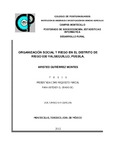Organización social y riego en el Distrito de Riego 030 Valsequillo, Puebla.
Abstract
La finalidad de este trabajo de investigación se ha enfocado al análisis e importancia del sistema de riego en la organización social de los usuarios o regantes y la capacidad organizativa de estos, para administrar en coordinación con la burocracia hídrica de la Comisión Nacional del Agua, en el distrito de riego 030 Valsequillo. Se muestra que existe intensa y complicada organización social para sostener el riego y que si bien existe una planeación central burocrática estatal a partir de la estructura principal o presa de almacenamiento y del canal principal, así como la entrega en bloque y el plan de riegos. También existe planificación y orden social comunitario autogestivo a partir de la infraestructura secundaria, orden social que es necesario resaltar para tenerlo en cuenta. Se describe la estructura social que integra a los usuarios del riego, que se coordinan para resolver la escasez del agua, bajos rendimientos, altos costos de producción, precios bajos de los productos básicos y que se vinculan alrededor de una serie de tareas. El compromiso de esta investigación es retomar como plataforma teórica, conceptual y metodológica los elementos planteados por la visión de la teoría social del riego, (Palerm y Martínez). _______________ SOCIAL ORGANIZATION AND IRRIGATION IN THE 030 IRRIGATION DISTRIC VALSEQUILLO, PUEBLA. ABSTRACT: The objective of this research work has focused on the analysis and the importance of the irrigation system, in the social organization of the users or irrigators and their organizational capability in order to administrate, in coordination with the hydric bureaucracy of the National Water Commission, in the 030 irrigation District in Valsequillo, Puebla in México. It is shown that, there is an intensive and complicated social organization to sustain irrigation, although a central governmental bureaucracy planning exits from the main structure or storage dam and the main waterway, as well as block delivery and the irrigation plan. Likewise, planning and self-management community, social order exists from secondary infrastructure. Such social order is important to highlight in order to take it into account. The social structure that integrates irrigation users is described. Such users manage themselves to solve the water shortage, low yields, high production costs, and low basic product prices, which are linked around a series of tasks. The commitment of this research is to retake, as theoretical, conceptual and methodological platform, the elements proposed for the view of social irrigation theory, (Palerm and Martínez).
Collections
- Tesis MC, MT, MP y DC [317]


